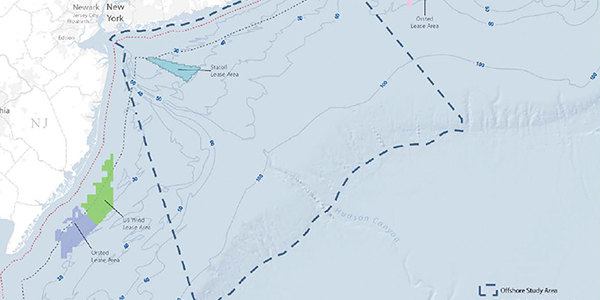By Rich Heidorn Jr.
NEW YORK — U.S. grid operators may have to consider a different way of transmission planning for offshore wind, panelists told the Business Network for Offshore Wind’s 2019 International Partnering Forum last week.
Speakers said interconnections to the land-based grid should be shared “social” resources and that queue positions shouldn’t be a deciding factor in states’ OSW solicitations.
Christer af Geijerstam, president of Equinor Wind US, said locating offshore cables is not a concern. “But if you are targeting substations that are 20 miles inland, how many times do you want to go dig up that same road for future projects? Should we pre-invest in capacity?”
Sven Utermöhlen, board member for E.ON Climate & Renewables, agreed that a long time horizon is essential to OSW transmission planning.
“If you think about 15 to 20 individual projects in the next decade or so to be constructed, you may find that there is only a handful of really suitable, sensible grid connection points … you better have a plan in place because you don’t want to dig up the same onshore connection route five times over the next 15 years.”
Repeated construction could undermine public support and complicate permitting, he said. “So, you better start thinking about a real network development plan.”
Clarke Bruno, lead partner for Anbaric Development Partners, said New York will have to expand its onshore grid to move its planned 9,000 MW of offshore wind from delivery points on Long Island and in New York City.
“Long Island [is] about a 2,400-MW load. Taking half of that 9,000 MW and trying to drop 4,500 MW into a 2,400-MW system is going to be a challenge. The same is true in New York City [with] a much larger average load of 6,400 [MW].
“There are very few interconnection points in Long Island and New York that have the degree of robustness that you would like to have. And … getting from offshore to those interconnection points, you have very few good routes, given the congestion on Long Island and the wetlands and, in New York City, the bottleneck of the Verrazano Narrows. So, with those challenges in mind, it strikes me that a planned transmission system is essential.”
The state must “plan and permit the offshore wind so that we are able to … seize the optimal interconnection points and allow equal access to all developers to those very scarce social resources.”
Gil Quiniones, CEO of the New York Power Authority, agreed with Bruno’s description of the challenges.
“Long Island, especially on the East End … we [say] ‘the wires are thinner.’ And New York City is very dense and [does not have] a lot of very easily accessible connection points. … Logic tells you that there is maybe an opportunity to have a collector system … and bring it to the optimal interconnection point. It does require planning. It requires all the regulatory bodies — state and federal — to be aligned in making that happen.”
State officials and grid operators have only begun to consider the transmission challenges of offshore wind.
The New York State Energy Research and Development Authority’s OSW Master Plan, published in January 2018, said an expandable “backbone” transmission system would offer economies of scale and reduced barriers to entry but could also lead to overbuilding and stranded asset costs. A transmission system custom-built for a single offshore facility — the “direct radial” model — would be less efficient and is limited in scope, the report said. (See NY Offshore Wind Plan Faces Tx Challenge.)
Proposed offshore wind projects in Connecticut (1,760 MW), Rhode Island (1,056 MW) and Massachusetts (6,064 MW) represent almost half of the 18,600 MW in ISO-NE’s transmission queue, Alan McBride, the RTO’s director of transmission and strategy services, told the IPF conference in a presentation.
PJM Begins Talks on OSW Tx Rules
In February, PJM’s Planning Committee approved a problem statement to consider granting merchant transmission developers capacity interconnection rights (CIRs) for offshore wind. (See “PC Moves Forward on Offshore Interconnection Rights,” PC/TEAC Briefs: Feb. 7, 2019.)
Current rules allow merchant transmission developers to obtain transmission injection and withdrawal rights for DC facilities or controllable AC facilities connected to a control area outside the RTO. Under the problem statement, stakeholders will consider allowing merchant transmission developers to request CIRs, or equivalents, for non-controllable AC transmission offshore.
Offshore transmission developers want to acquire CIRs so PJM can identify the necessary network upgrades.
The key difference from the normal procedure is that the developers want to build transmission before the generation is sited. Without generation at the other end of the line, PJM cannot perform stability or short-circuit analyses.
The first meeting of the initiative, on April 16, will consist of education about the RTO’s current process. Three months of exploration into alternative options are planned before members will return to the PC in August to consider endorsement of proposed changes.




